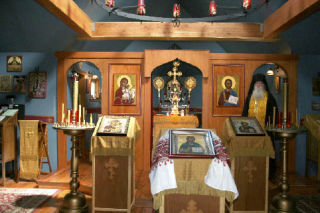Father Tryphon is nervous. A crane hovers above the temple at the All-Merciful Saviour Russian Orthodox Monastery in Dockton, and at its feet is the cobalt-blue onion dome for which the abbot has been waiting a decade.
There are many reasons to be nervous. The biggest, of course, is the question of whether the dome and the gold three-bar cross that tops it will hold together as they’re lifted by the crane before being carefully placed atop the monastery’s temple.
But also, Father Tryphon admits he’s afraid of heights. As the monastery’s abbot, he must mount the cherry picker and bless the dome once it’s placed on the temple’s cupola. But as the order’s spiritual teacher, he is comfortable sharing his fears with the monks and visitors who have gathered for the event.
“Part of the role of being a teacher is being real,” says the former psychologist and teacher. “When others know of our struggles, it gives them more encouragement to overcome theirs.”
It’s been 20 years since the order was “chosen by Vashon,” as Father Tryphon puts it. The monks, who lived in Oregon at the time, were in Seattle for Holy Week and paid a visit to Vashon.
“Our immediate experience was how very friendly and accepting Islanders were,” he says. “They didn’t look at us like we were strange. They were very inclusive of a variety of people.”
Soon after, the order rented a home on Maury and began to dream of a monastery that would be a worthy destination for monks and pilgrims. The journey from dream to reality has taken a generation and has involved struggle, but also remarkable generosity, craftsmanship and community spirit.
The monastery that has now come into fruition — crowned by the dome that makes it truly Russian — was built on land donated by John and Georgia Ratzenberger. Father Tryphon designed the monastery, with the help of architect James Bryant, to blend Orthodox tradition with the Pacific Northwest environment. For the latter, they based the buildings on Norwegian architecture, while Orthodox tradition mandated the complex’s layout.
The buildings surround a central courtyard with a fountain for the “great blessing of waters.” The temple sits on the east side of the courtyard. Facing it is the monastery’s new dining hall. The library is to the south, and on the north is the future book shop, which is still under construction. The site also holds seven cabins, or cells, for the monks, who currently number five.
From the outside, the buildings seem simple, in keeping with their surroundings. But the interiors are another story — lush, warm and inviting. The temple is striking, with cobalt blue walls lined with icons (paintings of saints), gold chandeliers, an elaborately decorated iconostatis, or icon screen, and a Brazilian tigerwood floor. The library is made cozy with comfortable furniture, leather-bound book collections and walls of paintings and photos.
“Beauty is an integral part of the whole Orthodox concept of worship,” explains Bryant, who offered his services as an architect for free and, over the course of the building process, converted and became a deacon himself. He is now called Father James. “When in Genesis, God says of creation, ‘It is good,’ the word ‘good’ innately means beautiful. When we create anything in Orthodox tradition, the concept is to be integral with God’s creation and further that.”
For many years, however, the monastery was mostly empty foundations. The foundations were laid a decade ago. The temple was the first to be built, then the library. To save money to complete the buildings, in 2004 the order hired a contractor who required payment up front to purchase materials. In the end, the “contractor” swindled the order out of $54,000.
That’s when God blessed the monks with “many golden hands,” says Father Tryphon, as numerous Islanders stepped in with money, supplies and labor. The new buildings were constructed “with God’s help and the blessing of a whole lot of community people. They did a huge amount of work for us that stretched our money so that we got more for it, I believe, than we would have with the original plan.”
Island craftsmen Edward Pierson and Robert Fouty created the dome and the iconostatis, respectively, and now they’re on hand to watch the temple finally become complete. There’s a sprinkling of rain on Saturday afternoon as the crane begins to heave the heavy object skyward, but by the time the dome reaches the steeple, the skies have cleared.
It takes some time to align the dome just right, and all the while, Father Tryphon walks the perimeter of the church, watching anxiously. The dome, he tells the crowd, represents the flame of a candle burning before the unseen face of God. The onion shape, he adds, made it easier to get the snow off in the cold climes of Russia.
Father James is clearly pleased by the progress being made. “It’s really nice to see it all coming together,” he said, adding, “Orthodox churches often take a long time to complete. It’s a lot like our own spiritual journey. We’re always a work in progress.”
With the dome mounted, this work in progress has clearly reached a milestone. This weekend, monks from all over the country will descend on the monastery for a pilgrimage. Father Tryphon smiles as he says, “We’re finally a destination point.”
Then it’s time for him to climb into the cherry picker. He cuts a striking figure with his long white beard, black robe and gold mantle as he ascends. Halfway up he calls, “It’s not so bad.”
It starts to rain again, and as Father Tryphon raises a horsetail brush to sprinkle the dome with holy water, an onlooker remarks, “Nature beat him to it.”
— Lesley Reed is a freelance writer who lives on Vashon.


